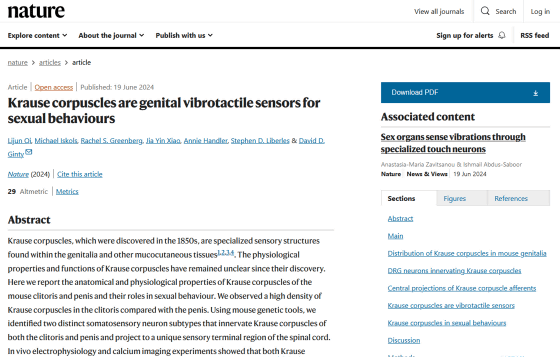The genitals have specialized nerve structures that sense 'light touch' and 'vibration.'

There are many organs and structures in the human body whose existence has been confirmed but whose functions remain unclear.
Krause corpuscles of the genitalia are vibrotactile sensors required for normal sexual behavior | bioRxiv
https://doi.org/10.1101/2023.06.14.545006

Mysterious Structures Appear to Play Unique Roles in Sexual Pleasure: ScienceAlert
https://www.sciencealert.com/mysterious-structures-appear-to-play-unique-role-in-sexual-pleasure
Krause corpuscles are capsule-shaped structures of nerves that are scattered around the genitals, lips, tongue, etc. Krause corpuscles were discovered by the German anatomist Wilhelm Krause around 1850, but their detailed function remained unknown.

To clarify the function of Krause corpuscles, the research team stained sections of the clitoris of female mice and the penis of male mice and counted the number of Krause corpuscles. As a result, it was found that there are almost the same number of Krause corpuscles in the clitoris and penis. However, because the penis has a larger volume than the clitoris, it was revealed that the density of Krause corpuscles is smaller.

Next, the research team used electrophysiological techniques and calcium imaging to find that Krause corpuscles are sensitive to 'light touch' and '40 to 80 Hz vibrations. 'Based on the results of the research, Lijun Qi, a member of the research team, said, 'Krause corpuscles in the genitals are vibrotactile sensors necessary for sexual behavior.'
In the new preprint, we found that Krause corpuscles of the genitalia are vibrotactile sensors required for normal sexual behavior. It was a great collaboration with Michael Iskols @MIskols . He is going to be an MD/PhD student @TriIMDPhD in New York starting next month! https://t.co/KDo0Vr1Y7m
— Lijun Qi (@leonard_qi) June 15, 2023
Although the results of the mouse experiment cannot be directly applied to humans, Krause corpuscles may be involved in the human response to light touch or vibration of the genitals.
Added June 21, 2024:
The paper passed peer review and was published in Nature.
Krause corpuscles are genital vibrotactile sensors for sexual behaviour | Nature
https://www.nature.com/articles/s41586-024-07528-4

The paper has attracted a great deal of attention and has even been featured in a column in Nature.
Sensory secrets of penis and clitoris unlocked after more than 150 years
https://www.nature.com/articles/d41586-024-02058-5

Related Posts:
in Science, Posted by log1o_hf







